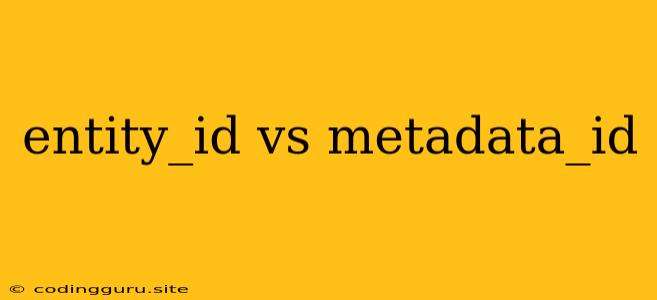Understanding the Difference Between entity_id and metadata_id
In the realm of data management and software development, we often encounter various identifiers to keep track of entities and their associated information. Two common identifiers that frequently arise are entity_id and metadata_id. While these terms sound similar, they represent distinct concepts that serve different purposes.
What is entity_id?
entity_id, often referred to as a primary key, is a unique identifier assigned to each individual entity within a database or system. Think of it as a passport number for each entity. This identifier is crucial for distinguishing one entity from another and for establishing relationships between entities.
What is metadata_id?
metadata_id, on the other hand, identifies a specific metadata record associated with an entity. It is not a direct identifier for the entity itself, but rather a unique identifier for the metadata describing that entity. Imagine metadata as a set of labels or tags providing extra information about an entity. For example, a metadata_id might identify a specific description, file type, or creation date related to an entity.
Why is it important to differentiate between entity_id and metadata_id?
Differentiating between entity_id and metadata_id is essential for several reasons:
- Data Integrity: Keeping these identifiers separate helps maintain data integrity by avoiding confusion and ensuring accurate relationships between entities and their metadata.
- Data Organization: Using distinct identifiers allows for efficient data organization, enabling easy retrieval and management of both entities and their associated metadata.
- Querying and Analysis: Differentiating these identifiers enables more precise and effective querying and analysis of data, as you can specifically target entities or their metadata based on their respective identifiers.
Let's illustrate with a practical example:
Imagine a database containing information about books. Each book would have a unique entity_id representing its individual identity within the database. However, each book might also have multiple metadata records associated with it, such as author, genre, publication date, and cover image. Each metadata record would have its own metadata_id.
In this case, you could use the entity_id to retrieve all information about a specific book, including its associated metadata. Alternatively, you could use the metadata_id to retrieve specific information about the book, like its publication date or genre.
Common scenarios where entity_id and metadata_id are used:
- Content Management Systems (CMS): entity_id might identify a blog post, while metadata_id could identify the category or tags associated with that post.
- E-commerce Platforms: entity_id might identify a product, while metadata_id could identify its description, specifications, or reviews.
- Social Media Platforms: entity_id might identify a user, while metadata_id could identify their profile picture, location, or interests.
Tips for using entity_id and metadata_id effectively:
- Clearly define the purpose of each identifier: Establish clear definitions for both identifiers to avoid ambiguity and ensure consistent usage throughout your system.
- Maintain consistency: Use consistent naming conventions for identifiers to enhance readability and reduce confusion.
- Use appropriate data types: Choose appropriate data types for each identifier based on its intended purpose and the expected range of values.
Conclusion:
Understanding the difference between entity_id and metadata_id is crucial for effective data management and software development. By correctly identifying and utilizing these identifiers, you can ensure data integrity, improve data organization, and facilitate efficient data querying and analysis.
